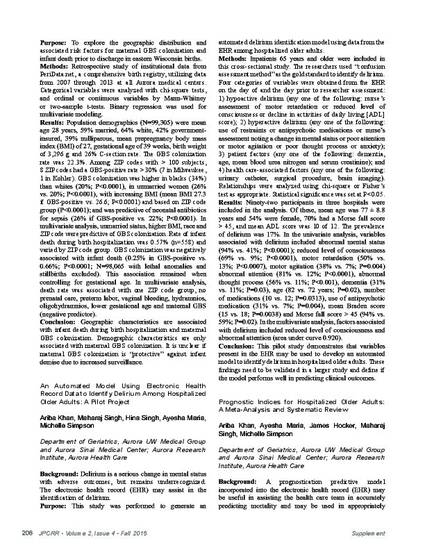
- delirium,
- electronic health record,
- older patients
Background: Delirium is a serious change in mental status with adverse outcomes, but remains underrecognized. The electronic health record (EHR) may assist in the identification of delirium.
Purpose: This study was performed to generate an automated delirium identification model using data from the EHR among hospitalized older adults.
Methods: Inpatients 65 years and older were included in this cross-sectional study. The researchers used “confusion assessment method” as the gold standard to identify delirium. Four categories of variables were obtained from the EHR on the day of and the day prior to researcher assessment: 1) hypoactive delirium (any one of the following: nurse’s assessment of motor retardation or reduced level of consciousness or decline in activities of daily living [ADL] score); 2) hyperactive delirium (any one of the following: use of restraints or antipsychotic medications or nurse’s assessment noting a change in mental status or poor attention or motor agitation or poor thought process or anxiety); 3) patient factors (any one of the following: dementia, age, mean blood urea nitrogen and serum creatinine); and 4) health care-associated factors (any one of the following: urinary catheter, surgical procedure, brain imaging). Relationships were analyzed using chi-square or Fisher’s test as appropriate. Statistical significance was set at P < 0.05.
Results: Ninety-two participants in three hospitals were included in the analysis. Of these, mean age was 77 ± 8.8 years and 54% were female, 70% had a Morse fall score > 45, and mean ADL score was 10 of 12. The prevalence of delirium was 17%. In the univariate analysis, variables associated with delirium included abnormal mental status (94% vs. 41%; P < 0.0001); reduced level of consciousness (69% vs. 9%; P < 0.0001), motor retardation (50% vs. 13%; P < 0.0007), motor agitation (38% vs. 7%; P = 0.004) abnormal attention (81% vs. 12%; P < 0.0001), abnormal thought process (56% vs. 11%; P < 0.001), dementia (31% vs. 11%; P = 0.03), age (82 vs. 72 years; P = 0.02), number of medications (10 vs. 12; P = 0.0313), use of antipsychotic medication (31% vs. 7%; P = 0.004), mean Braden score (15 vs. 18; P = 0.0038) and Morse fall score > 45 (94% vs. 59%; P = 0.02). In the multivariate analysis, factors associated with delirium included reduced level of consciousness and abnormal attention (area under curve 0.920).
Conclusion: This pilot study demonstrates that variables present in the EHR may be used to develop an automated model to identify delirium in hospitalized older adults. These findings need to be validated in a larger study and define if the model performs well in predicting clinical outcomes.
Available at: http://works.bepress.com/maharaj-singh/39/
